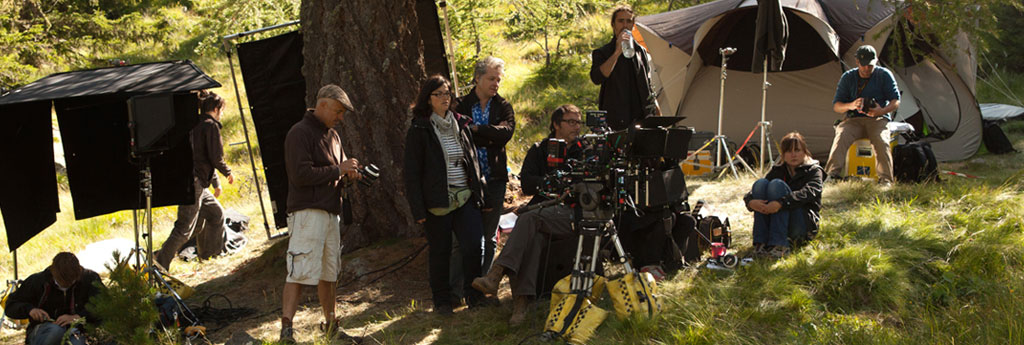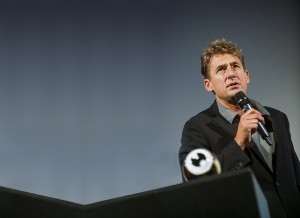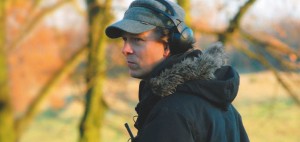
There are no guidelines which dictate that any meat need to be served on set of a film production. Nevertheless, this topic is still a matter of debate. A heavyweight argument that speaks against this is called Gunda. In his same-named black and white silent film, the Russian cameraman and filmmaker Victor Kossakovsky visualizes the life of a pig on a farm. For Joaquin Phoenix, Executive Producer, it is a film of profound importance and artistry.
How did you prepare this film?
Victor Kossakovsky: It starts with finding the right actors for the film. Normally, I spend a lot of time before I discover the heart of my film. In this case, it was very easy. We met Gunda on the very first day of our research. In this case, I opened the door to the pigsty, Gunda came towards me. She was so cinematic, so powerful. Her look was so strong. So I told my producer Anita Rehoff Larsen: We have found our Meryl Streep.
 What kind of camera concept did you choose?
What kind of camera concept did you choose?
I looked at her house where she lives and we designed the same house as her house but with a 360 degree hole for lense. We put trolley rails around it and we were outside but the lense was inside. So there was a little hole just for the lense. Wherever she was, we were just able to move around. We did not disturb her because only the lense was inside, all the camera and the people were outside. She was also gentle with us, she was so friendly – even in the moment when she gave birth she was okay with us. She was a dream character.
What kind of equipment did you use?
We used the Alexa-Mini which is very convenient and easy to use for such kind of documentary. It is really fast, really small. We used an Angénieux zoom 24 – 190. It was We made some light but very little so that we don’t disturb. It was almost invisible. The house has a lot of dark corners so we made some little additions to lit the corners. We took a disco ball and we put light and it gave these spots in the house. Normally, a disco ball is moving that is why it creates but if you don’t move it, it gave there spots in the whole house. Whereever she goes, she eventually comes to the light. It was smart to use a disco ball. This is all what we did with lights.
It was obviously that we don’t know where the piglet will go. There are many piglets and you don’t know where they go. If you have light everywhere, it will destroy everything. But these little spots of light are looking quite natural because there are holes in the roof and it looks like that some light from the roof is shining into the house.
W hy did you decide to shoot the film in black and white?
hy did you decide to shoot the film in black and white?
The decision to shoot in black and white was made for a similar reason. For one thing, this brings me back to the origin of cinema, to the birth of cinema. Also, depending on the circumstances, color can be overwhelming. If you see blood in color, it is too naturalistic and your attention wanders. Often, lush colors will make us focus on different things, such as the background. I didn’t want to show cute pink piglets – and believe me, they are very cute indeed. I didn’t want to seduce the viewer in that way. It felt to me like black and white makes us focus on their soul rather than their appearance.
At the end of the film we see her looking for her piglets are gone. How often does it happen to a pig like this?
Two times a year. Piglets normally live between two and six months, then we kill them and eat them. This is what we do. But Gunda lives in priviliged conditions compared to the rest of the pigs. At least she has freeedom. It is a very good from in Norway. 90 percent of the pig at farms have no chance to tig. they stay their whole live on the concrete floor in a small cage.
 Do farmers not see animals anymore as living beings?
Do farmers not see animals anymore as living beings?
I hope that peoople will face it that we are too cruel. At the moment, we are sharing life with seven billion people. And we have one billion pigs living in cages. And 1.5 billion cows living in horrible conditions and 50 billion chickens living in cages all their life. We have to face it. We have to stop doing it.
Do you want to open people’s eyes?
Documentary cinema is a great tool to show the realities of the world, to show things that we do not see by ourselves, that we do not want to see, or that we have collectively agreed that we do not see, and so we allow ourselves not to think about. With Gunda want people to see these animals as sentient beings and to encourage them to think about the possibility of their consciousness and selfhood. With that I feel that Gunda is the most personal and important film I have made as a filmmaker and as a human being.
Photos: © Victor Kossakovsky













 Robert Redford
Robert Redford Hannes Jaenicke
Hannes Jaenicke Nic Balthazar
Nic Balthazar Nadeshda Brennicke, Actress
Nadeshda Brennicke, Actress Darren Aronofsky, Director, Noah / Jury President, 65th Berlin International Film Festival
Darren Aronofsky, Director, Noah / Jury President, 65th Berlin International Film Festival Tim Bevan
Tim Bevan Thekla Reuten
Thekla Reuten Rachael Joy
Rachael Joy Nikola Rakocevi
Nikola Rakocevi Nadja Schildknecht
Nadja Schildknecht Michael Bully Herbig
Michael Bully Herbig Lars Jessen
Lars Jessen Helen Hunt
Helen Hunt Douglas Trumbull
Douglas Trumbull Dieter Kosslick, Director Berlin International Film Festival
Dieter Kosslick, Director Berlin International Film Festival Benoit Delhomme
Benoit Delhomme Jeremy Irons
Jeremy Irons
Thank you, for writing this article, Sir or Ms., for publishing it Sir or Ms. and for filming this beautiful, beautiful film, Mr. Kossakvosky.
‘Gunda’ is extraordinary. So lovely & heartbreaking , truly throughout the entire film. This film… whew, mind blown. Heart, obviously , is broken for Mama. Who would NOT be heartbroken, grieving, just sad,sad, sad!!!!! You captured Mama’s ‘befuddlement’ , her panic, her very quick optimism( one of the few that I know of that felt her short-lived belief she’d find them) then I guess some other emotions I seem to have missed as I went to mama’s despair & knowledge they were gone- their sent was gone…
I won’t eat animal flesh anymore. Can’t. Poor , poor, POOR , CONFUSED, SAD MAMA ANIMALS
NO WAY WILL I EAT THEM AGAIN. Thank you , all involved with this beautiful, Necessary film. Thank you